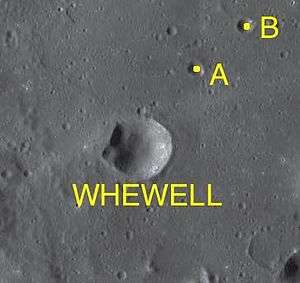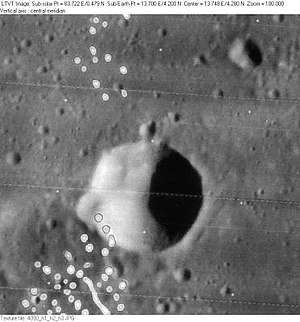Whewell (crater)
|
Whewell crater, northeast is its satellite crater Whewell A | |
| Coordinates | 4°12′N 13°42′E / 4.2°N 13.7°ECoordinates: 4°12′N 13°42′E / 4.2°N 13.7°E |
|---|---|
| Diameter | 13 km |
| Depth | 2.3 km |
| Colongitude | 347° at sunrise |
| Eponym | William Whewell |
Whewell is a lunar impact crater that lies on a stretch of lava-resurfaced terrain to the west of Mare Tranquillitatis. It is located about 25 km east of the disintegrated crater Tempel and north-northwest of D'Arrest. More than 25 km east is Cayley, a slightly larger but very similar formation. To the North lies the Rima Ariadaeus, which is a linear rille that is 300 kilometers long and was formed when a section of the Moon's crust sank down between two parallel fault lines, producing a graben. Further north again, lies the 90 km wide crater Julius Caeser.
Its diameter is 12 km long and is 2,300 meters deep. Also, the area is around 140 km² and the perimeter is about 45 km.
Crater Whewell is named after the 19th century philosopher and naturalist, William Whewell.

This is a circular, bowl-shaped crater with interior walls that slope down gently to a small interior floor. This crater has not been significantly eroded, and the rim is well-defined. A small unnamed crater to the north is attached with Whewell. Also in that area, there are two smaller curves and a large curve towards the southwest which originated from smaller crater impacts.
Satellite craters
By convention these features are identified on lunar maps by placing the letter on the side of the crater midpoint that is closest to Whewell. They are Whewell A and B which are wholly located northeast.
| Whewell | Latitude | Longitude | Diameter |
|---|---|---|---|
| A | 4.7° N | 14.1° E | 4 km |
| B | 5.0° N | 14.5° E | 3 km |
References
- Andersson, L. E.; Whitaker, E. A. (1982). NASA Catalogue of Lunar Nomenclature. NASA RP-1097.
- Blue, Jennifer (July 25, 2007). "Gazetteer of Planetary Nomenclature". USGS. Retrieved 2007-08-05.
- Bussey, B.; Spudis, P. (2004). The Clementine Atlas of the Moon. New York: Cambridge University Press. ISBN 978-0-521-81528-4.
- Cocks, Elijah E.; Cocks, Josiah C. (1995). Who's Who on the Moon: A Biographical Dictionary of Lunar Nomenclature. Tudor Publishers. ISBN 978-0-936389-27-1.
- McDowell, Jonathan (July 15, 2007). "Lunar Nomenclature". Jonathan's Space Report. Retrieved 2007-10-24.
- Menzel, D. H.; Minnaert, M.; Levin, B.; Dollfus, A.; Bell, B. (1971). "Report on Lunar Nomenclature by the Working Group of Commission 17 of the IAU". Space Science Reviews. 12 (2): 136–186. Bibcode:1971SSRv...12..136M. doi:10.1007/BF00171763.
- Moore, Patrick (2001). On the Moon. Sterling Publishing Co. ISBN 978-0-304-35469-6.
- Price, Fred W. (1988). The Moon Observer's Handbook. Cambridge University Press. ISBN 978-0-521-33500-3.
- Rükl, Antonín (1990). Atlas of the Moon. Kalmbach Books. ISBN 978-0-913135-17-4.
- Webb, Rev. T. W. (1962). Celestial Objects for Common Telescopes (6th revised ed.). Dover. ISBN 978-0-486-20917-3.
- Whitaker, Ewen A. (1999). Mapping and Naming the Moon. Cambridge University Press. ISBN 978-0-521-62248-6.
- Wlasuk, Peter T. (2000). Observing the Moon. Springer. ISBN 978-1-85233-193-1.
External link
| Wikimedia Commons has media related to Whewell (crater). |
Other articles
- Wood, Chuck (December 12, 2006). "How Deep is That Hole". Lunar Photo of the Day. Archived from the original on August 3, 2017. - includes a couple of craters such as Whewell
- Wood, Chuck (March 17, 2013). "A Russian Masterpiece". Lunar Photo of the Day.
